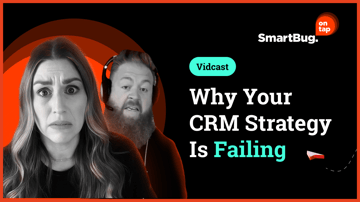
Alexandra Whitmore
VP of Sales
SmartBug Media
Abigail Allen
SVP of Sales
SmartBug Media

Breaking down the limits of ATS—and where HubSpot fills the gaps.
Alexandra Whitmore (00:14):
Hey everyone, and welcome to SmartBug on Tap, the podcast where we unpack smarter strategies for growth using HubSpot and beyond. I'm your host, Alexandra Whitmore, VP of Sales here at SmartBug Media.
If you're in staffing, chances are your ATS has been both a lifeline and a limitation. Maybe it's great at tracking placements, but not so great at enabling candidate engagement, marketing alignment, or pipeline visibility. Sound familiar? Then this episode’s for you.
Today we’re tackling a big question: Is it time to fire your ATS? We’ll break down what HubSpot can and can’t do for staffing firms, and how to know whether you need a better integration, a total overhaul, or just a smarter strategy.
Joining me is Abigail Allen, EVP of Sales at SmartBug Media and a true veteran of the staffing industry. Over the past two decades, she’s held executive-level sales and operations roles, giving her an inside look at how technology impacts a firm’s success. She’s worked with agencies nationwide to drive operational efficiencies and ensure recruiting and sales teams get the most out of their tools. Abigail, welcome to the show.
Abigail Allen (01:22):
Thank you for having me. This topic is definitely in my wheelhouse. I’ve spent a lot of time in the trenches with staffing firms facing this challenge, so I’m excited to unpack it.
Alexandra Whitmore (01:34):
Let’s kick things off. What are the core functions of an ATS versus a CRM like HubSpot?
Abigail Allen (01:42):
An ATS—Applicant Tracking System—is essentially your system of record. Think of it as a digital filing cabinet designed to manage the application process and store candidates. It’s transactional and compliance-focused: parsing resumes, tracking applicants.
A CRM like HubSpot, on the other hand, is your system of engagement. It manages the entire journey for both candidates and clients, unifying marketing, sales, and recruitment data in one connected platform.
Alexandra Whitmore (02:25):
Love that. Why do staffing firms feel limited by their ATS?
Abigail Allen (02:30):
Every staffing firm runs two business units: sales and recruitment. Their day-to-day needs are very different, but an ATS is specialized only for tracking applicants. That creates limitations.
On the recruitment side, ATS-only setups often:
-
Create a reactive “post and pray” model where recruiters start from scratch every time.
-
Lead to poor candidate experiences, where resumes sit in a “black hole” with no follow-up or nurturing.
-
Provide limited context. Candidates are more than resumes, but an ATS doesn’t show their engagement with your brand or potential as a client lead.
On the sales side, ATS limitations include:
-
Siloed communication: sales lacks visibility into recruiter interactions with the same clients.
-
No ability to nurture client relationships with automation, segmentation, or engagement tracking.
-
Weak reporting and forecasting: you can see placements and time-to-fill, but not conversion rates, pipeline velocity, or sales cycle metrics.
Overall, relying solely on an ATS creates inefficiencies for both sales and recruitment.
Alexandra Whitmore (06:27):
What happens when firms try to use their ATS as a CRM—or their CRM as an ATS?
Abigail Allen (06:33):
It’s painful. I’ve seen firms try to force one system to do the other’s job. It leads to friction, missed opportunities, and inefficiency.
Using an ATS as a CRM? Sales teams end up living in spreadsheets and email with no visibility for marketing, no nurturing, and no accurate forecasting. Growth becomes guesswork.
Using a CRM as an ATS? That’s even riskier. CRMs aren’t built for compliance, resume parsing, or nuanced skills-based searches. Firms risk legal complications and lose crucial efficiencies.
The best solution is not to replace your ATS with a CRM, but to supplement it with HubSpot for engagement, workflows, and visibility.
Alexandra Whitmore (08:50):
So how can HubSpot improve the candidate experience?
Abigail Allen (09:21):
HubSpot eliminates the candidate “black hole.” For example:
-
Applicants can receive personalized emails outlining next steps and resources, not just canned responses.
-
Candidates who don’t get the role can be added to talent networks and nurtured with newsletters, webinars, or insights.
-
Recruiters can automate check-ins for “silver medalists,” re-engage inactive candidates, or segment passive talent with relevant content.
This creates proactive, human-like engagement and keeps your firm top of mind.
Alexandra Whitmore (12:37):
What about reporting—what can HubSpot show that ATS platforms can’t?
Abigail Allen (12:56):
HubSpot provides visibility into why things happen, not just what happened. It tracks source attribution, ROI of marketing channels, pipeline health, candidate engagement, and the full contact timeline across sales, marketing, and recruiting. Everyone sees the same truth, eliminating silos.
Alexandra Whitmore (14:09):
So when should a firm integrate their ATS with HubSpot, and when should they replace the ATS entirely?
Abigail Allen (14:12):
Integrate if your ATS does its core job well—compliance and application workflows—but doesn’t connect with sales and marketing.
Replace if your ATS is clunky, slow, lacks modern APIs, or forces teams into spreadsheets. At that point, it’s not a tool, it’s a roadblock.
Alexandra Whitmore (15:43):
What does a healthy ATS + CRM ecosystem look like?
Abigail Allen (15:46):
Best of breed. Your ATS handles compliance and placements, while HubSpot manages client relationships, candidate nurturing, marketing, and sales. Data flows seamlessly between the two. Recruiters, sales, and marketing all work from the same playbook.
Alexandra Whitmore (16:58):
How can SmartBug help teams evaluate their setup?
Abigail Allen (17:06):
We start by listening—understanding what’s working, what’s breaking, and your goals. Then we help map the ideal state: whether you need a tighter integration or a new system altogether. If HubSpot is the right fit, we don’t just set it up—we build workflows, reports, and strategies to help your recruiters and sales team succeed.
Alexandra Whitmore (17:51):
Abigail, thank you so much for your insights. For leaders at staffing firms, if your ATS is holding you back or your systems aren’t working together, it may be time to rethink your strategy. Whether you integrate or replace, HubSpot can be a powerful solution when implemented the right way.
If you’re ready to assess whether your tech stack is helping or hurting, check out the link in the description to schedule a consult with our team.
Thanks for tuning in to SmartBug on Tap. We’ll see you next time!








